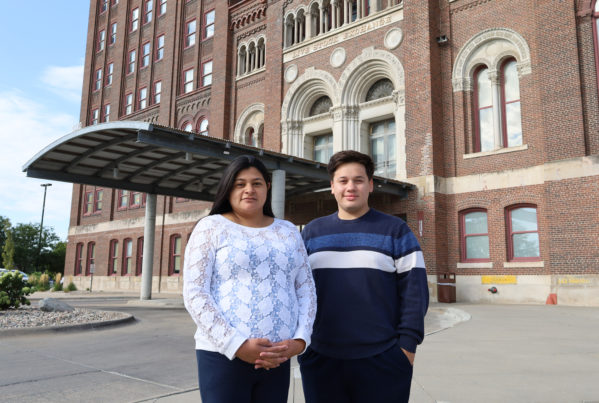Seeing the bigger picture
OneWorld teams address drivers of health

Social Worker Jair Alvarez and Behavioral Health Therapist Karla Deacon.
Sometimes helping a patient requires digging a little deeper into their inner and outer worlds. Take, for example, a patient who visits her primary care provider for support managing her diabetes. After learning she’ll need to take insulin, the patient becomes stressed. Insulin needs to be refrigerated, and her utilities are about to be shut off due to lack of funds. She’ll have no way to keep the insulin cold. Her anxiety rises.
The interdisciplinary teams of OneWorld are prepared. In this hypothetical scenario shared by Associate Director of Operations Idania Ramirez, the primary care provider would contact the Social Services team to assess the patient’s living, working and other conditions, sometimes referred to as social drivers of health. The assessment could reveal other needs, like food insecurity or lack of transportation, that are also affecting the patient.
“That physical representation of unmet needs looks like a patient who is very overwhelmed, who is presenting a lot of symptoms of anxiety, depression and maybe even triggering other behavioral health needs that otherwise wouldn’t be presenting in the way they are in that appointment,” Ramirez said.
This is just one example of how a patient’s current economic situation could stand in the way of ongoing medical treatment, while heightening the need for behavioral health care. As Social Services staff members work to address the patient’s resource barriers, a Behavioral Health Therapist could also be called to provide mental health support. The therapist might help the patient with coping mechanisms for her stress and anxiety, or provide a safe space to talk about what is going on.
Social drivers of health attempt to describe the big picture affecting an individual’s well-being: the socioeconomic conditions, environmental conditions, institutional power and social networks, according to the National Association of Community Health Centers’ PRAPARE toolkit. For example, the assessment explores personal characteristics like race, ethnicity, language and work status, taking into consideration systemic racism and inequality. It also delves into housing status and neighborhood; money and other resources; social connection and stress; and safety.
Understanding that big picture helps a patient’s care team provide the right resources.
“Many patients are depressed because the finance, because the food, because the housing, and many external factors that are related with resources in the community,” said Longfellow Marquez, LIMHP, LMHP, LADC, Behavioral Health Therapist and Licensed Alcohol and Drug Counselor Trainer. “That’s also the component for the holistic treatment that we can provide to the patient.”
It’s the role of the Social Services team to get to the heart of a patient’s specific social drivers of health, acting as a third pillar of support along with medical and behavioral health staff. Social Services support is available to established patients who have seen a provider in the past year and are otherwise eligible for OneWorld Services. Sometimes Social Services staff begin providing support while meeting with the patient, as in the above example. At other times, they may work behind the scenes to identify community resources and follow up with a call.
Depending on the situation, Behavioral Health staff might arrange to work with a patient over time – or may only have a brief session with them alongside a primary care visit. Behavioral Health Therapist Karla Deacon, LMHP, LADC, said these brief sessions can include discussions about the mind-body connection, or how current stressors might be expressed physically. For example, a patient who has been suffering from headaches might share that their spouse has lost a job, which opens a discussion on managing anxiety.
But sometimes patients are living with ongoing effects of systemic or political realities – those “upstream” social drivers of health that lead to the worst outcomes for the least powerful. Deacon said many OneWorld patients experience the complexity of having been forced to leave their home country in order to survive, while enduring the separation from loved ones who remain. They may send money back to support family members, while living in poverty here.
“And so there’s no easy answer because there’s systems in place that make it difficult for them to overcome some of the barriers to their happiness,” Deacon said. “So it is unique here. We’re dealing with the depression, anxiety and the trauma that looks different. It feels systemic.”
OneWorld’s providers understand that a person’s needs – medical, behavioral and social – are all connected. And even if there isn’t a quick fix for all the social drivers of health that impact a patient, there is a team committed to their overall well-being. Social Worker Jair Alvarez said that’s part of what makes OneWorld unique.
“I think it’s very special that you can see your primary care physician, see behavioral health and see social work all in the same visits,” Alvarez said. He added: “We want to make sure we meet basic needs, so that they understand their mental health is very important, and [we] want them to continue seeing their doctor and therapist here so that overall, they can have a better, healthier life.”



